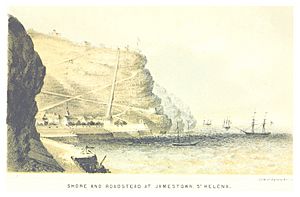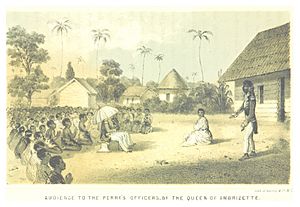USS Perry (1843) facts for kids
class="infobox " style="float: right; clear: right; width: 315px; border-spacing: 2px; text-align: left; font-size: 90%;"
| colspan="2" style="text-align: center; font-size: 90%; line-height: 1.5em;" | 
|}
The USS Perry (1843) was a type of sailing ship called a brig. It was built for the United States Navy before the American Civil War. The Perry had many important jobs. These included helping with diplomatic issues, serving in the Mexican–American War, fighting against the slave trade, and taking part in the American Civil War. The ship was likely named after Commodore Oliver Hazard Perry, a famous naval hero.
The Perry was built at the Norfolk Navy Yard and launched in May 1843. It officially joined the Navy on October 13, 1843, with Commander Samuel F. Du Pont in charge.
Contents
| History | |
|---|---|
| Builder | Norfolk Navy Yard |
| Laid down | date unknown |
| Launched | May 1843 |
| Commissioned | 13 October 1843 |
| Decommissioned | 25 September 1845 |
| Recommissioned | 16 May 1846 |
| Decommissioned | 14 July 1849 |
| Recommissioned | 17 November 1849 |
| Decommissioned | 26 December 1851 |
| Recommissioned | 27 April 1852 |
| Decommissioned | 20 July 1854 |
| Recommissioned | 20 March 1855 |
| Decommissioned | 27 April 1855 |
| Recommissioned | 21 January 1858 |
| Decommissioned | 15 June 1860 |
| Recommissioned | 23 April 1861 |
| Decommissioned | 3 January 1863 |
| Recommissioned | 28 February 1863 |
| Decommissioned | 29 April 1865 |
| Fate | Sold 10 August 1865 |
| General characteristics | |
| Displacement | 280 tons |
| Length | 105 ft (32 m) |
| Beam | 25 ft 6 in (7.77 m) |
| Draft | 13 ft 2 in (4.01 m) |
| Depth of hold | 12 ft 3 in (3.73 m) |
| Propulsion | sail |
| Speed | varied |
| Complement | 67 |
| Armament |
|
Adventures Around the World
The Perry began its first big journey on December 3, 1843. It sailed from Norfolk, Virginia, and visited many places. These included Rio de Janeiro in Brazil, Cape Town in South Africa, and the Sunda Strait. The ship arrived in Macau on August 27, 1844.
In Macau, the Perry picked up Caleb Cushing. He was the first American Commissioner to China. The ship then sailed to Hong Kong and later to the coast of Mexico. It arrived in Mazatlán on November 4. Four days later, Cushing left the ship at San Blas to travel home.
Protecting Whalers in the Pacific
After Mexico, the Perry sailed to Honolulu, Hawaii. Then it visited the Society Islands and the Marquesas Islands. In these islands, the ship helped make sure American whalers were treated fairly. It worked to gain respect for them. The Perry left Tahiti on April 16, 1845. It then visited Valparaíso, Chile, and sailed around the southern tip of South America. The ship returned to Norfolk, Virginia, on September 17 and was taken out of service on September 25.
Serving in the Mexican-American War
The Perry was put back into service on May 16, 1846. This was just three days after the Mexican–American War began. Four days later, it sailed to the Gulf of Mexico. Its job was to block Mexican ports, stopping ships from entering or leaving.
Surviving a Hurricane
While sailing from Havana to Charleston, South Carolina, the Perry faced a huge hurricane on October 10, 1846. The storm pushed the ship over reefs near Bahia Honda Key. Amazingly, everyone on board survived this dangerous event. The crew managed to pull the ship off the reefs. It then went to Philadelphia, Pennsylvania, for repairs, arriving on December 4, 1846.
Fighting the Slave Trade
On May 16, 1847, the Perry left Philadelphia. It joined the Brazil Squadron. This group of ships protected American interests between Rio de Janeiro and Buenos Aires. The Perry received information about ships suspected of being involved in the illegal slave trade. These ships often used fake documents.
Capturing Illegal Ships
On December 16, the Perry captured an American ship called Ann D. Richardson near Rio de Janeiro. Two days later, it captured another American ship, the brig Independence. Investigations showed that both ships were involved in the slave trade. They were sent to New York City with special crews. The Perry returned to Norfolk on July 10, 1849, and was taken out of service soon after.
More Missions Against the Slave Trade
The Perry was put back into service on November 17, 1849. It sailed to the west coast of Africa. Its mission was to help stop the slave trade. Except for a short time in New York City, the ship continued this important duty. It returned to Norfolk on July 14, 1854, and was taken out of service again.
Diplomatic Mission to Paraguay
The Perry remained out of service for most of the time until January 21, 1858. It then sailed from Hampton Roads on February 15. Its new mission was to join an expedition to Paraguay. This expedition was led by Flag Officer William B. Shubrick. The goal was to protest an attack on another U.S. Navy ship, the USS Water Witch.
The group of ships arrived in Asunción, Paraguay, on January 29, 1859. Their presence helped the U.S. Special Commissioner, James B. Bowlin, get a respectful meeting. The strong naval force achieved what years of talking had not. Paraguay apologized for the attack. They also paid money to the family of an American sailor who was killed. A trade agreement that benefited the United States was also signed. The Perry returned to New York on June 5, 1860, and was taken out of service ten days later.
Serving in the American Civil War
The Perry was inactive until the American Civil War began in April 1861. It was quickly put back into service on April 23, 1861. Under Commander John J. Glasson, it immediately headed south. The ship escorted three transport ships carrying about 3,000 troops. These troops landed in Annapolis, Maryland, to help protect the nation's capital.
Blockading and Protecting the Capital
The Perry then returned to New York City to prepare for its new role as a blockader. It joined the new Atlantic Blockading Squadron on May 18. A week later, it sailed south to Fernandina Beach, Florida. On May 31, it captured a Confederate ship called Hannah M. Johnson near Cape Lookout, North Carolina. The Perry also captured the Confederate privateer Chotank (1861) on June 3. It also turned away two British ships from the Southern coast.
With low water supplies and needing repairs, the Perry sailed north on July 8. It reached Washington D.C. on July 21. This was just before the Union Army lost the first Battle of Bull Run. To protect the capital, the Perry moved into the Potomac River. Its guns could guard the approaches to Alexandria, Virginia, against any possible Confederate attack. Some sailors from the Perry even went ashore to help man the cannons at Fort Ellsworth. The ship continued to serve in the Potomac Flotilla and captured two more ships, Blooming Youth and Ellen Jane.
Missions in Colombia and North Carolina
In late December, the Perry sailed to Aspinwall, Colombia. It arrived there on May 14, 1862. The ship headed home on November 13 and was taken out of service in New York on January 3, 1863, for repairs.
The Perry was put back into service on February 28, 1863. A month later, it took its station off New Inlet, North Carolina. On March 31, it captured a ship called Sue. On May 1, it captured another ship, the Alma. This ship was trying to sneak into Beaufort, North Carolina, carrying salt and herring from Bermuda. The Perry sailed north on August 13.
Final Blockade Duty

After repairs in Boston, Massachusetts, the Perry joined the South Atlantic Blockading Squadron. It arrived at Port Royal, South Carolina, on November 15, 1863. It served off Murrell's Inlet, North Carolina, and then off Charleston, South Carolina, during the siege. On January 28, 1864, it sailed to its blockade station off Fernandina Beach, Florida. The Perry stayed there until the Civil War ended.
End of Service
The USS Perry was officially taken out of service in Philadelphia, Pennsylvania, on April 29, 1865. It was then sold at a public auction there on August 10, 1865.



